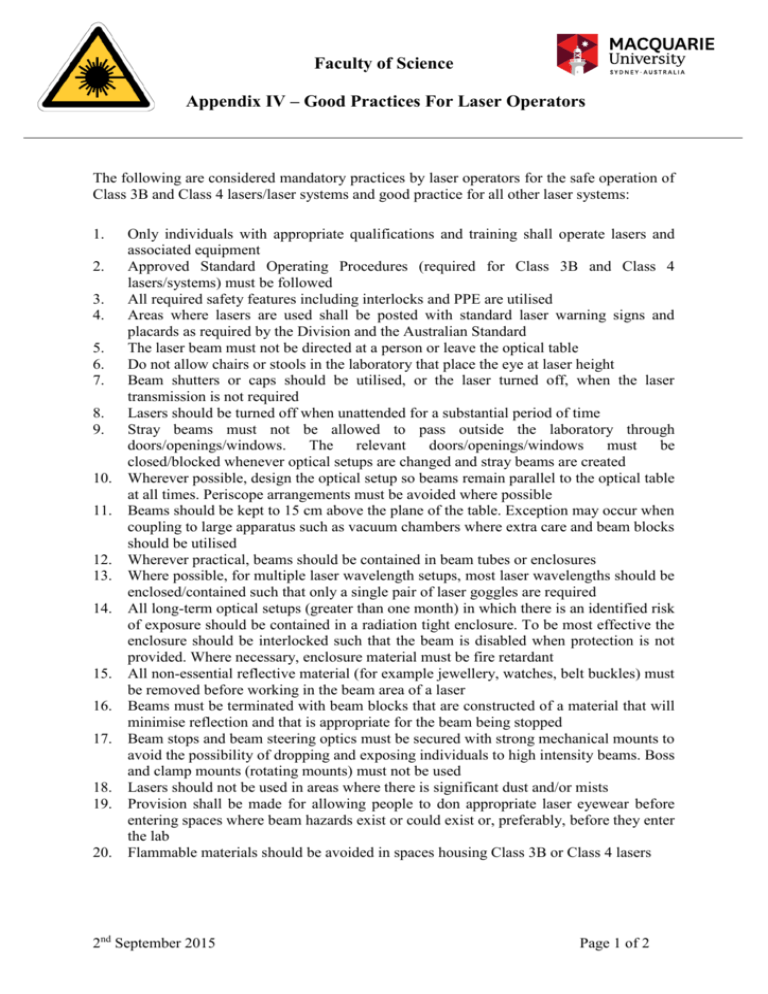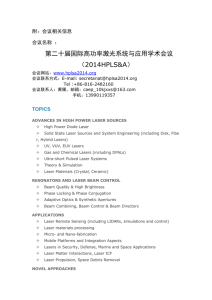Good Practices For Laser Operators
advertisement

Faculty of Science Appendix IV – Good Practices For Laser Operators The following are considered mandatory practices by laser operators for the safe operation of Class 3B and Class 4 lasers/laser systems and good practice for all other laser systems: 1. 2. 3. 4. 5. 6. 7. 8. 9. 10. 11. 12. 13. 14. 15. 16. 17. 18. 19. 20. Only individuals with appropriate qualifications and training shall operate lasers and associated equipment Approved Standard Operating Procedures (required for Class 3B and Class 4 lasers/systems) must be followed All required safety features including interlocks and PPE are utilised Areas where lasers are used shall be posted with standard laser warning signs and placards as required by the Division and the Australian Standard The laser beam must not be directed at a person or leave the optical table Do not allow chairs or stools in the laboratory that place the eye at laser height Beam shutters or caps should be utilised, or the laser turned off, when the laser transmission is not required Lasers should be turned off when unattended for a substantial period of time Stray beams must not be allowed to pass outside the laboratory through doors/openings/windows. The relevant doors/openings/windows must be closed/blocked whenever optical setups are changed and stray beams are created Wherever possible, design the optical setup so beams remain parallel to the optical table at all times. Periscope arrangements must be avoided where possible Beams should be kept to 15 cm above the plane of the table. Exception may occur when coupling to large apparatus such as vacuum chambers where extra care and beam blocks should be utilised Wherever practical, beams should be contained in beam tubes or enclosures Where possible, for multiple laser wavelength setups, most laser wavelengths should be enclosed/contained such that only a single pair of laser goggles are required All long-term optical setups (greater than one month) in which there is an identified risk of exposure should be contained in a radiation tight enclosure. To be most effective the enclosure should be interlocked such that the beam is disabled when protection is not provided. Where necessary, enclosure material must be fire retardant All non-essential reflective material (for example jewellery, watches, belt buckles) must be removed before working in the beam area of a laser Beams must be terminated with beam blocks that are constructed of a material that will minimise reflection and that is appropriate for the beam being stopped Beam stops and beam steering optics must be secured with strong mechanical mounts to avoid the possibility of dropping and exposing individuals to high intensity beams. Boss and clamp mounts (rotating mounts) must not be used Lasers should not be used in areas where there is significant dust and/or mists Provision shall be made for allowing people to don appropriate laser eyewear before entering spaces where beam hazards exist or could exist or, preferably, before they enter the lab Flammable materials should be avoided in spaces housing Class 3B or Class 4 lasers 2nd September 2015 Page 1 of 2 Faculty of Science Appendix IV – Good Practices For Laser Operators 21. 22. 23. 24. Provisions shall be made for storing laser dye solutions, solvents, and other flammable materials safely Provisions shall be made for grounding electrical components and optical benches safely Gas mixtures should be stored in gas storage cabinets. Associated gas storage cabinets shall be connected to an appropriate exhaust ventilation system When using a Class 3B or Class 4 laser for experiments, the laser operator (lab manager or supervisor for undergraduate students) must undertake a risk assessment of the experimental procedure before turning the laser on for the first time. 2nd September 2015 Page 2 of 2





